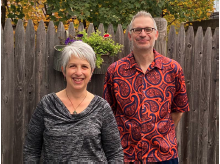Last updated on
A Brother, A Sister, and a Clotting Disorder: Joelle and Matthew’s Story
In the spring of 2001, Matthew Hochman felt some unusual pain in his right calf. As an avid basketball player, he thought he’d pulled a muscle during a game. “My calf felt like a rock, and the pain persisted for several weeks and began to move up my leg. I called the doctor and was sent for an ultrasound. They found a pretty massive clot in my leg – it had moved from my calf up to my mid-thigh,” he recalls. “I was admitted to the hospital for 5 days, then sent home with a prescription for warfarin and was told to follow up with a hematologist.”
What Matthew didn’t know at the time was that his father is an asymptomatic carrier for protein S deficiency, a disorder that causes abnormal blood clotting.* “In addition, my uncle Stuart, my father’s brother, had his first bout with deep vein thrombosis (DVT) at the age of 15 and also tested positive for protein S deficiency. He started taking warfarin as a teenager and has been on it for nearly 65 years. My family and I joke that Uncle Stuart is perhaps the longest living person on warfarin! His daughter (our cousin) also has this clotting disorder, so it clearly runs in our family.”

About 6 months after Matthew’s DVT, his older sister Joelle found herself in the hospital. “I was pregnant and developed preeclampsia (high blood pressure in pregnancy). My platelets were dropping and I had high protein levels in my urine, so the doctors decided to induce labor. I had a C-section and was very worried about having a blood clot. With our family history and all the things going on with my labor, it was a real concern,” she says. “Matthew found out that he had protein S deficiency at that first follow-up appointment after his clot and was prescribed lifelong anticoagulation. I wasn’t tested for the disorder because of my pregnancy. The doctor told me to wait until I was a few months postpartum.”
Shortly after delivering her baby, Joelle started having pain in one of her calves. “I was nervous. I asked practically everybody that would come in my hospital room if this pain was normal. I told everyone that I had a family history of blood clotting and that my brother just had a DVT. It felt like no one was taking me seriously. I was just encouraged to walk around as much as I could,” she explains.
A week later, Joelle brought her daughter to their family doctor for a newborn checkup and mentioned that her leg pain hadn’t gone away. The doctor ordered an ultrasound, which came back negative. “At that point, I felt like a hypochondriac. I thought, alright, I’ll get a massage or some body work and it will help. I started wearing compression stockings that went all the way up to my thigh, too.”
As the end of the year approached, Joelle’s leg pain began radiating to her groin. She was becoming progressively short of breath and noticed that she was also having pain in her chest and back. “I’d never had pain like this before – I was basically crouching in my hallway. My doctor was away for the holidays, so I spoke to his associate on the phone. She thought that the pain may have been coming from nursing my daughter, or from my C-section, and told me not to come in. I admit that I kind of downplayed my symptoms because I was an otherwise healthy woman who never really had any medical issues.”
At the urging of a friend many days later, Joelle went to the emergency room. Despite her negative ultrasound a few weeks earlier, the doctors found several emboli throughout both lungs. She was admitted to the hospital, started on anticoagulation, and discharged with heparin shots. A few months later, a blood test confirmed that she—like her brother, uncle, and cousin—had protein S deficiency.
After a follow-up with a hematologist, Joelle started taking warfarin. “My clots were considered to be heavily provoked by my pregnancy and labor/delivery. Given those factors, my doctor and I came to the decision that I would only stay on warfarin for 6 months.”
Fast-forward to January 2018. It had been 17 years since Matthew and Joelle had their initial blood clots. Matthew was doing well on his warfarin and hadn’t had any recurrent clots. Joelle, on the other hand, remembers standing on her tip-toes one day to reach for something and feeling an intense charley horse in her calf. An ultrasound later confirmed that she had a DVT.
“My experience with blood clots has been a huge wakeup call. When I think back to my first clot, I wasn’t able to take my symptoms seriously. I was worried about being a burden, and that was more of a concern than my own health – even though I had a life-threatening situation. I still struggle with this issue, and I think women sometimes minimize their symptoms and pain and put other things ahead of their health. I’ve since made a pact with myself that if I’m worried about another blood clot, I’m going to act. I’m going to call the doctor and get an ultrasound. An ultrasound isn’t putting anybody out in the grand scheme of things.”
“I echo my sister,” says Matthew. “Regardless of having a clotting disorder, you have to take your own health seriously and really advocate for yourself.”
Joelle and Matthew have both started to see a vascular medicine specialist for annual checkins. Matthew has transitioned from warfarin to rivaroxaban (Xarelto), and Joelle has also started taking rivaroxaban daily. She is now a respiratory therapist, in part due to her experience with PE. “I’d tell any of my patients not to doubt themselves and to get help if they’re having a respiratory issue or pain. Even if it turns out to be nothing serious, it’s better to be safe than sorry.”
| * WHAT IS PROTEIN S DEFICIENCY? |
| When you bleed, there are chemical reactions involving proteins (called coagulation factors) that activate to stop the bleeding. Protein S helps regulate these reactions to protect your body from excessive blood clotting. Blood may clot abnormally without protein S, resulting in a DVT or PE. This disorder can be acquired but is usually inherited (caused by a genetic mutation). U.S. National Library of Medicine – MedlinePlus. 2020. |
*Originally published in The Beat – December 2020. Read the full newsletter here.



